ChatGPT for Data Analysis (without technical skills)
All of us work with data regardless of our role, but very few of us were actually taught how to analyze data in a structured way.
Luckily for us, with AI tools like ChatGPT, we're able to level the playing field by using proven frameworks to extract meaningful insights in minutes instead of hours.
Let's get started!
Watch it in action
Resources
- Prompts + Datasets - Follow along with the same data used in the tutorial
- Coursera - The course I took is "ChatGPT + Excel: Master Data, Make Decisions, Tell Stories"
The Problem We All Face
Most of us work with data regularly but were never formally trained in data analysis.
Whether you're in management consulting, account management, or product marketing, you've likely struggled with extracting insights from spreadsheets. The traditional solution - learning SQL, Python, or advanced Excel - takes months or years to master.
Enter the DIG Framework
After taking the top-rated AI for data analysis course on Coursera, I discovered that the key to using ChatGPT effectively isn't about complex prompts - it's about giving it a proven framework to follow.
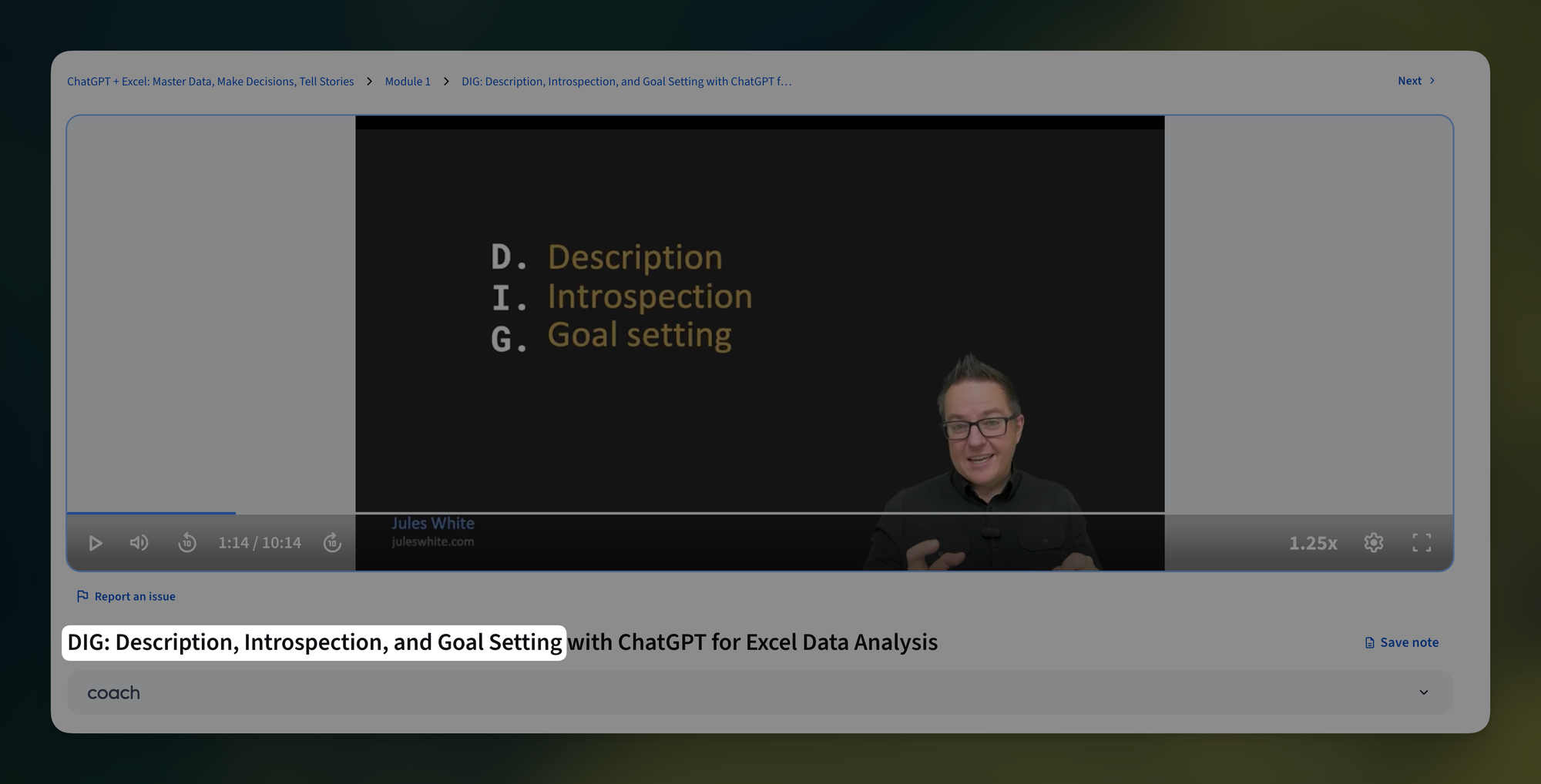
The DIG framework stands for:
- Description: Understand what's in your data
- Introspection: Discover what questions your data can answer
- Goal Setting: Focus your analysis on what matters
Think of it this way: when someone hands you a spreadsheet with no context, you start at 0% understanding. But with each DIG prompt you feed to ChatGPT, your comprehension increases systematically. By the end, you've uncovered insights that would have taken hours to find manually, if you found them at all.
Step 1: Description - Understanding Your Data
Imagine this scenario: your colleague just quit and left you with a massive spreadsheet and zero documentation. Where do you even start?
The Description phase helps ChatGPT explain what's in your file quickly and effectively. Here are the essential prompts:
Prompt 1: Get the lay of the land
"List all the columns in the attached spreadsheet and show me a sample of data from each column."
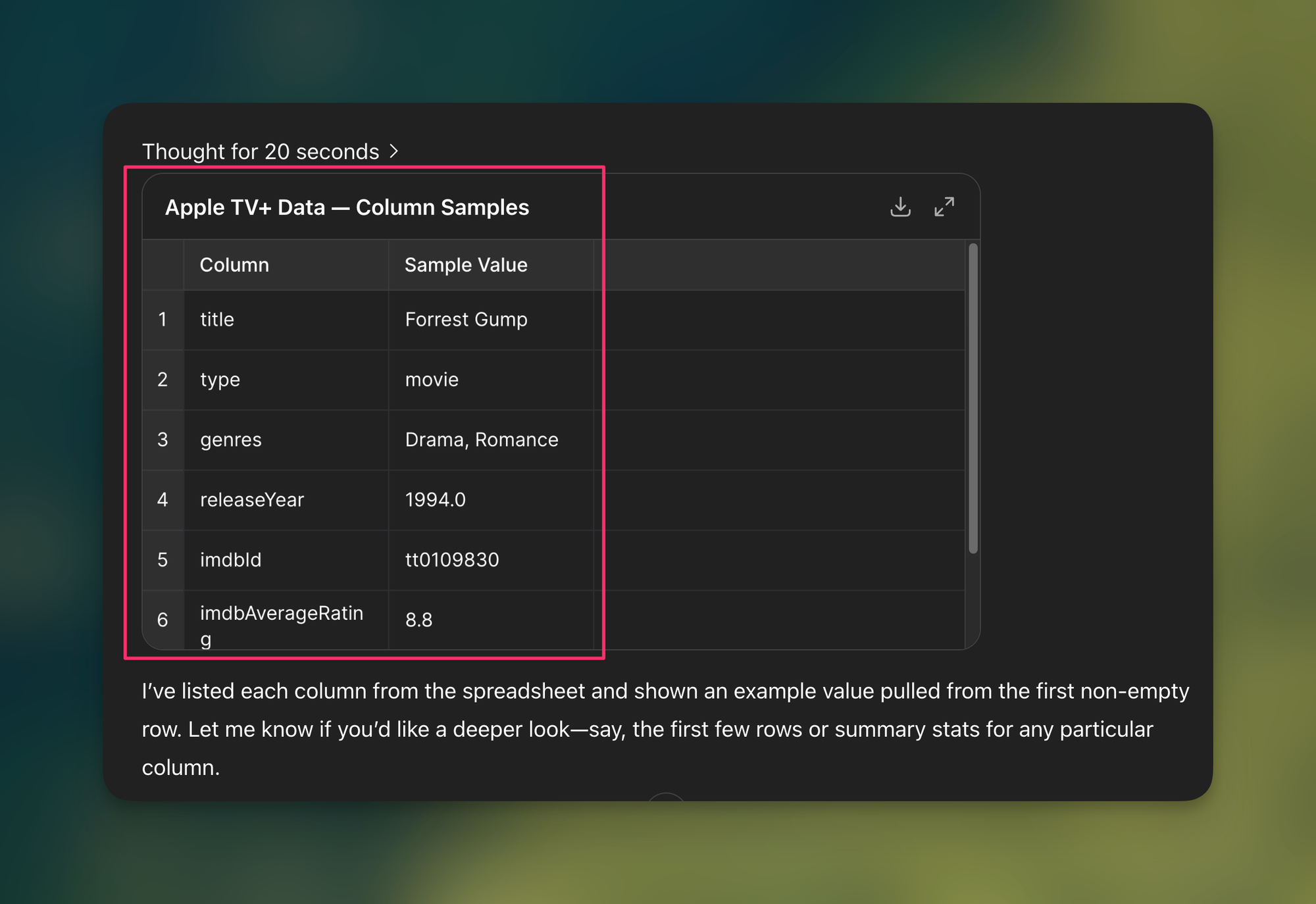
This forces ChatGPT to examine every column and gives you a digestible overview. Instead of staring at thousands of rows, you see one clear example that helps you understand the data structure.
Prompt 2: Verify with multiple samples
"Take 5 more random samples of the data for each column to make sure you understand the format and type of information in each column."
Why multiple samples? That first example might be an outlier. Multiple samples help you spot patterns and inconsistencies, like discovering some movies have one genre while TV shows might have three.
Prompt 3: Run quality checks
"Run a data quality check on each column. Specifically look for:
- Missing, null, or empty values (give me counts and percentages)
- Unexpected formats or data types
- Outliers or suspicious values"
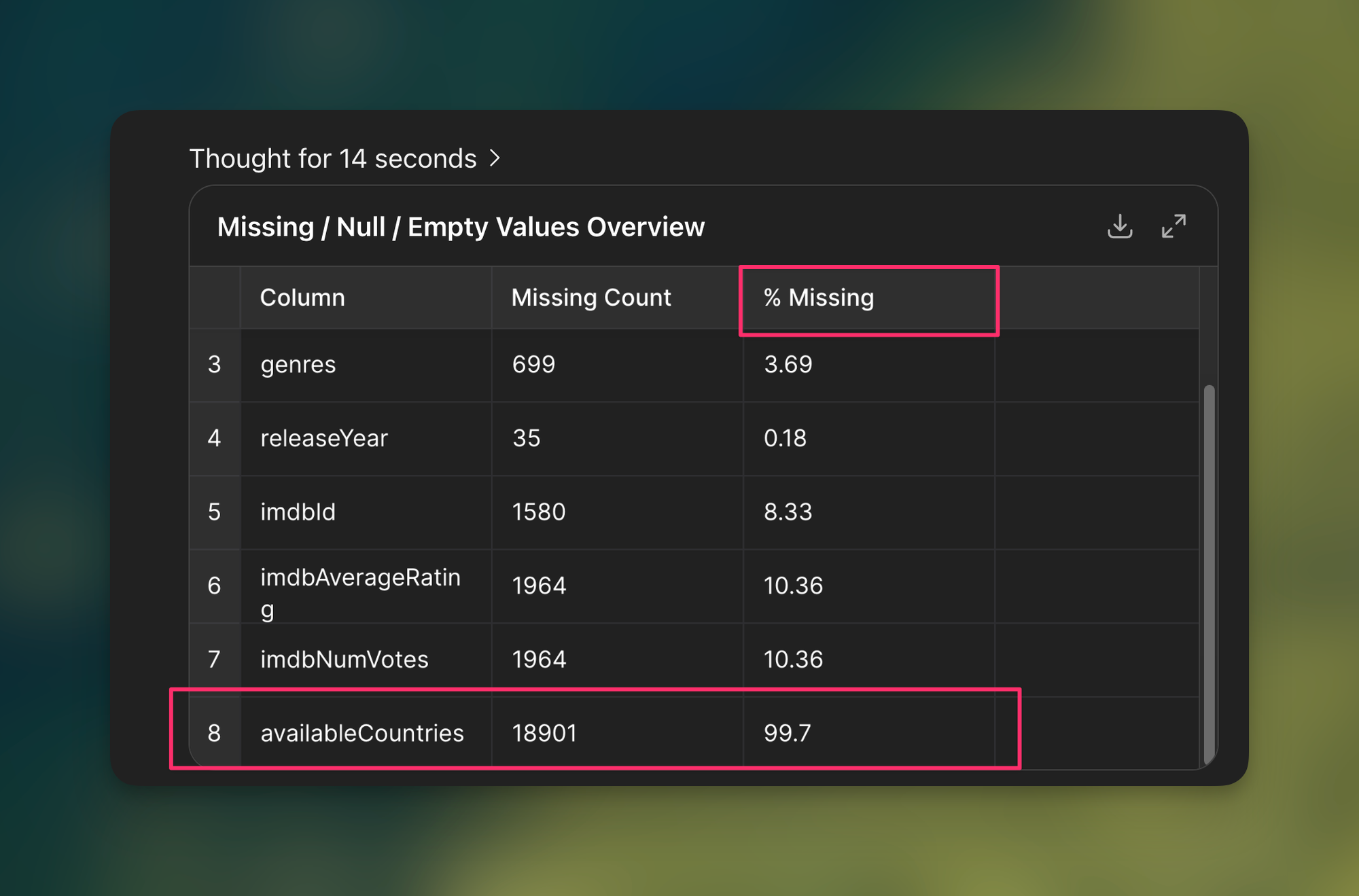
This is where ChatGPT becomes invaluable. In our Apple TV+ example, it discovered that 99.7% of the "available countries" column was empty, immediately telling us to avoid any geographical analysis with this dataset.
Step 2: Introspection - Discovering Hidden Insights
Now that you understand your data, it's time to brainstorm what insights it might contain. The Introspection phase is where ChatGPT helps you think like a data analyst.
Prompt 1: Surface valuable questions
"Tell me 10 interesting questions we could answer with this dataset and explain why each would be valuable."
Good questions indicate ChatGPT understands your data. In our example, it suggested analyzing questions like:
- "How has Apple TV+'s yearly output grown since launch?"
- "Which genres dominate the catalog, and how have they shifted over time?"
That second question is gold, imagine being on Apple's content team and discovering you need to diversify beyond your dominant genre.
Prompt 2: Verify feasibility
"For the first three questions, tell me exactly which columns you'd need to use and whether the current data is sufficient to answer it."
This forces ChatGPT to show its work and confirms whether these analyses are actually possible with your data.
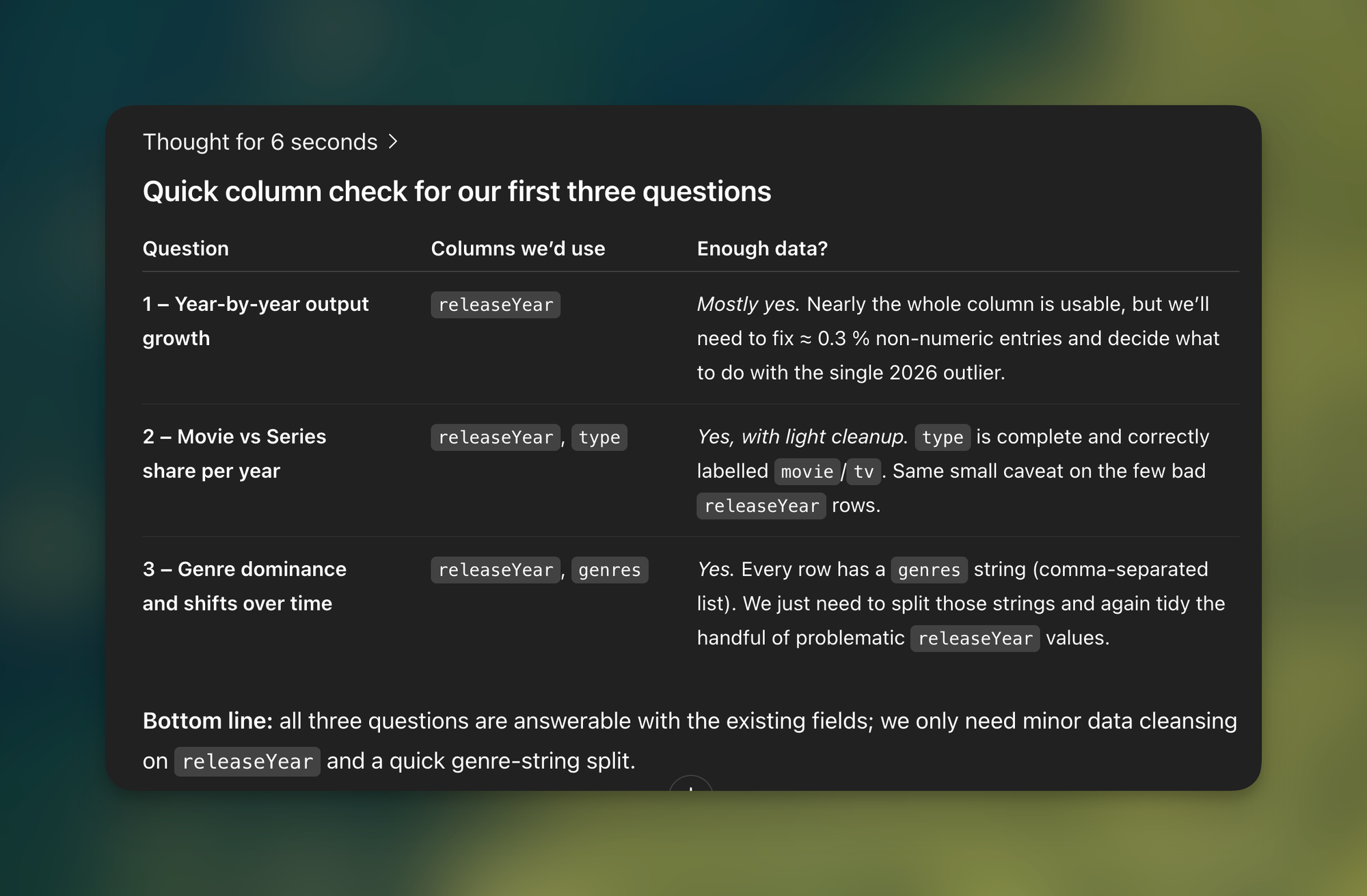
Prompt 3: Identify limitations
"What questions do you think someone would WANT to ask about this data but we CAN'T answer due to missing information?"
This brilliant prompt helps manage expectations. In our case, ChatGPT identified that we couldn't answer "What's the most-watched genre?" because we lacked viewership data.
Advanced technique: Merging datasets
Here's where it gets powerful. If you obtain additional data (like viewership numbers), you can upload it to the same ChatGPT conversation and ask:
"I just received this dataset from a colleague. Your task is to explore and explain the relationships between this new dataset and the original one and how they might be used to join data together."
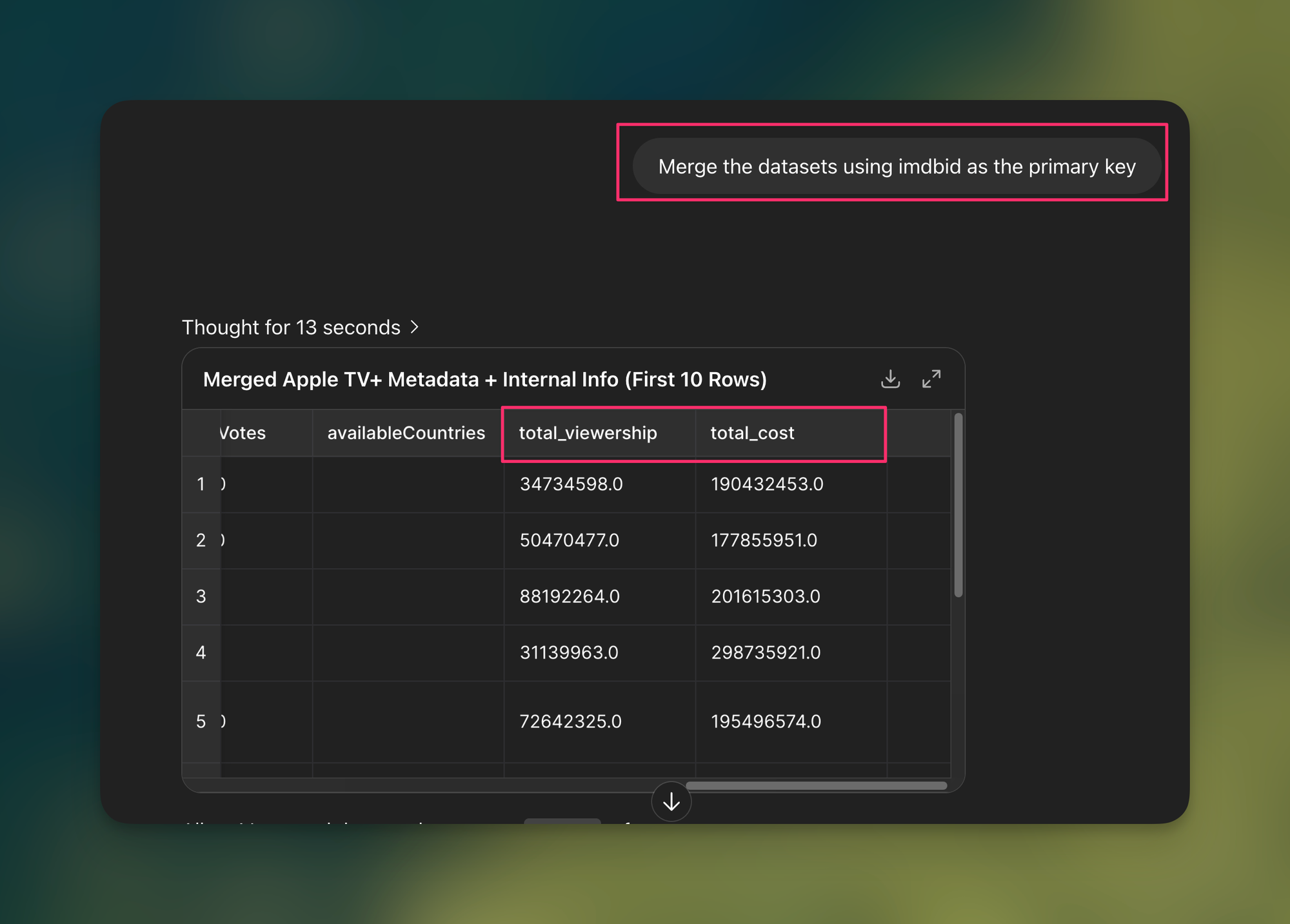
ChatGPT will identify common fields (like IMDB IDs) and can merge the datasets for you, opening up entirely new analysis possibilities.
Step 3: Goal Setting - Focus on What Matters
The biggest mistake in data analysis? Analyzing everything without a clear purpose. Goal Setting ensures your analysis delivers actionable insights.
The critical prompt:
"My goal is to understand [your specific goal]. Given this goal, which aspects of the data should we focus on?"
For example: "My goal is to understand what content Apple TV should invest in next."
ChatGPT then provides a focused roadmap:
- If you care about viewer demand, analyze this
- If you care about production efficiency, look at that
- Build a "genre scorecard" ranking opportunities
- Examine trend velocity (something you might not have considered)
This focused approach might surface insights like: "True-crime series deliver 3× the median views, cost 18% less per hour, and grew from 4% to 9% of watch-time over three years."
Pro tip for presentations:
Always ask: "What are the key questions someone reading my analysis would ask, and how should we proactively address them?"
This single prompt has saved countless presentations by anticipating tough questions from managers or skeptical colleagues.
Why This Framework Works
The DIG framework succeeds because it:
- Structures the chaos: Instead of randomly exploring data, you follow a proven sequence
- Leverages ChatGPT's strengths: The AI excels at pattern recognition and calculation when given clear direction
- Remains flexible: You can branch off at any point to explore interesting findings
- Requires zero coding: Everything happens through natural language conversation
If you enjoyed this
Check out my comprehensive guide on ChatGPT, see you there!